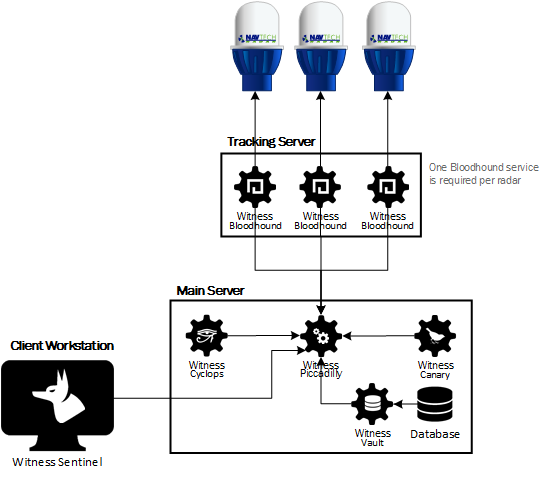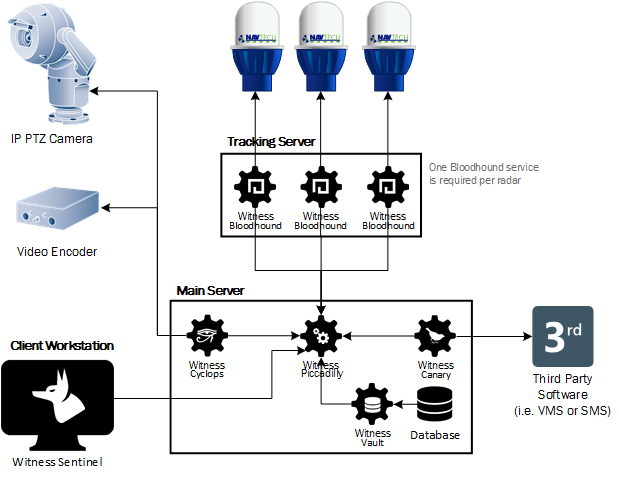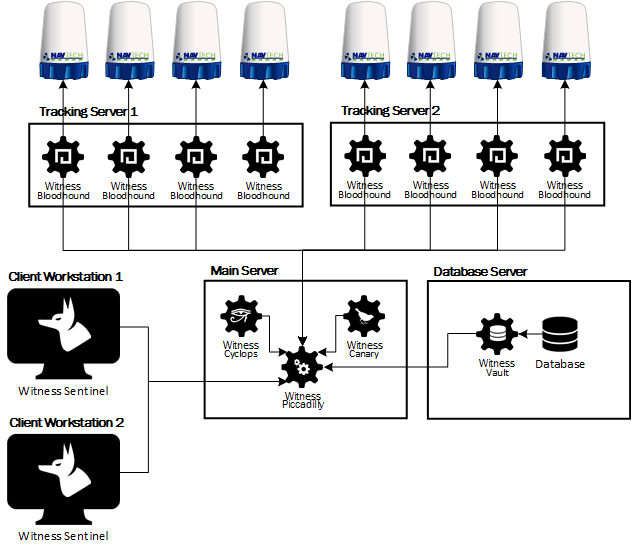Witness Software Components
| Application | Application Type | Description | How many |
|---|---|---|---|
| Piccadilly | Windows Service | Primary system server. Manages system configuration and coordinates all other services. | 1 per site |
| Sentinel | Windows Application | Radar management client (UI). It provides admin functions for installation and commissioning as well as a full operator interface for managing a site. | 1 or more (additional license costs may apply) |
| Canary | Windows Service | External interface service. This provides the functions required to integrate with 3rd party systems. | 1 per site |
| Cyclops | Windows Service | Camera control service. This provides the logic to administer and control all the cameras on site. | 1 per site |
| Bloodhound | Windows Service | Radar tracker. Provides the core tracking capability for each radar. | 1 per radar |
| Vault | Windows Service | Database management service. This provides the interface between the database storage engine and the rest of the application. | 1 per site |
| Hydra | Windows Service | Data splitter service. This service can be used on legacy radars to allow more than 1 client to connect to the same radar. | 1 per radar |
System Topology Overview
When considering the system design for Witness, the following points should be taken into account:
- All the different applications must be able to communicate with the Piccadilly service across the network.
- Because each radar requires its own Bloodhound application, installations with many radar will require the Bloodhound applications to be installed across several hardware systems. This spreads the network and processing load. Typically a single server can manage between 4-8 installations of Bloodhound. See x for more information on this (TBC).
- Installing the Vault service will also install the database service on the same system. Since V3.6 the database service is x64 and must be installed on a supported edition of Windows x64. See Witness Software Requirements.
- Due to the potential for high bandwidth usage on sites with many radar we recommend that all systems are installed on a 1Gbit network.
- Due to the 24x7 nature of the system, the quality of the network is critical. It is therefore essential that all network equipment, including switches, network interface cards and cables are all of an enterprise standard. This means you must not use low cost, small business or home equipment.
Typical System Topology
The following system diagram illustrates a simple 3 radar system. The setup includes a dedicated server for tracking with 3x Bloodhounds (1 per radar) and a primary server with the remainder of the software. The client software, Sentinel, is run from a standard PC. The two servers can be installed in a data centre or server room whilst the client PC will need to be located with the operators / users.
Typical System Topology with Cameras and Third-Party Integration
Witness Cyclops must have network access to any installed IP cameras or video encoders which are being used with Witness. Likewise, Witness Canary must have suitable network access to any third party system.
Typical Topology for a Medium Sized System
Note that in this scenario we have used an additional tracking server to cope with the additional Bloodhounds. We have also separated the database function onto a dedicated server. As a system uses more radar it will process many more tracks / targets. If you wish to record these tracks for later analysis or display, then the demand on the database is much greater - hence the requirement for a dedicated server. In addition all the tracks have to pass through Piccadilly for alarm analysis. This means the main server will also be more heavily utilised which is another reason to separate this function from the database.
Network Diagrams
We strongly recommend that a network diagram is created for every project, This will help identify the equipment needed, any issues in the design but more importantly provide a basis on which the project can be discussed with all those contributing to delivery.
Visio Stencils
In order to help our own engineers we created a simple set of Vision shapes that can be used to quickly develop network diagrams. Partners, system integrators and customers are welcome to use them. They can be on the download resources page.
Related
infoinformation
| Filter by label (Content by label) | ||||
|---|---|---|---|---|
|


